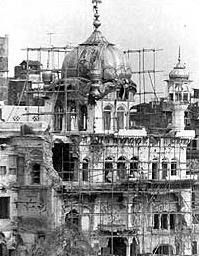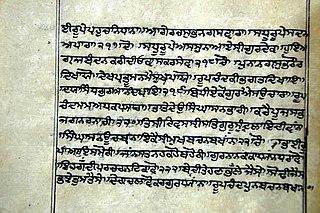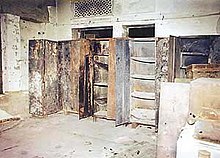
Operation Blue Star was an Indian Armed Forces operation between 1 and 10 June 1984 to remove Sikh militant Jarnail Singh Bhindranwale and other Sikh separatists from the buildings of the Golden Temple, the holiest site of Sikhism.

Jarnail Singh Bhindranwale was a Sikh militant. He was the leading figure of the Khalistan movement, although he did not personally advocate for a separate Sikh nation.

A gurdwara or gurudwara is a place of assembly and worship for Sikhs but its normal meaning is place of guru or "Home of guru". Sikhs also refer to gurdwaras as Gurdwara Sahib. People from all faiths and religions are welcomed in gurdwaras. Each gurdwara has a Darbar Sahib where the Guru Granth Sahib is placed on a takht in a prominent central position. Any congregant may recite, sing, and explain the verses from the Guru Granth Sahib, in the presence of the rest of the congregation.

The Guru Granth Sahib is the central holy religious scripture of Sikhism, regarded by Sikhs as the final, sovereign and eternal Guru following the lineage of the ten human gurus of the religion. The Adi Granth, its first rendition, was compiled by the fifth guru, Guru Arjan (1564–1606). Its compilation was completed on 29 August 1604 and first installed inside the Golden Temple in Amritsar on 1 September 1604. Baba Buddha was appointed the first Granthi of the Golden Temple. Shortly afterwards Guru Hargobind added Ramkali Ki Vaar. Later, Guru Gobind Singh, the tenth Sikh guru, added hymns of Guru Tegh Bahadur to the Adi Granth and affirmed the text as his successor. This second rendition became known as the Guru Granth Sahib and is also sometimes referred to as the Adi Granth.
The following outline is provides an overview of Sikhism, or Sikhi.

The Shiromani Gurdwara Parbandhak Committee is an organization in India responsible for the management of Gurdwaras, Sikh places of worship in states of Punjab and Himachal Pradesh and the union territory of Chandigarh. SGPC also administers Darbar Sahib in Amritsar.

The Damdamī Ṭaksāl, also sometimes referred to as Giani Samparda, Jatha Bhindra(n), or Sampardai Bhindra(n) is an orthodox Khalsa Sikh cultural and educational organization, based in India. They are known for their teachings of vidya as well as gurbanisanthiya. Its headquarters are located in the town of Mehta Chowk, approximately 40 km north of the city of Amritsar. It has been described as a seminary or “moving university” of the Sikh countryside.

The Akal Takht is one of five takhts of the Sikhs. It is located in the Darbar Sahib complex in Amritsar, Punjab, India. The Akal Takht was built by Guru Hargobind as a place of justice and consideration of temporal issues; the highest seat of earthly authority of the Khalsa and the place of the Jathedar, the highest spokesman of the Sikhs.

Kehar Singh was an Assistant in the erstwhile Directorate General of Supply and Disposal, New Delhi, and was tried and executed for conspiracy in the plot of the Indira Gandhi assassination, carried out by Satwant Singh and Beant Singh. He was hanged in Tihar Jail on 6 January 1989. Beant Singh was the nephew of Kehar Singh. The assassination was "motivated" by Operation Blue Star.

The principal Sikh scripture is the Adi Granth, more commonly called the Guru Granth Sahib. The second most important scripture of the Sikhs is the Dasam Granth. Both of these consist of text which was written or authorised by the Sikh Gurus.

Baba Deep Singh is revered among Sikhs as one of the most hallowed martyrs in Sikhism. He is remembered for his sacrifice and devotion to the teachings of the Sikh Gurus. Baba Deep Singh was the first head of Misl Shaheedan Tarna Dal – an order of the Khalsa military established by Nawab Kapur Singh, the then head of Sharomani Panth Akali Buddha Dal. The Damdami Taksal also state that he was the first head of their order.

Sikh architecture is a style of architecture that was developed under the Sikh Confederacy and Sikh Empire during the 18th and 19th centuries in the Punjab region. Due to its progressive style, it is constantly evolving into many newly developing branches with new contemporary styles. Although Sikh architecture was initially developed within Sikhism its style has been used in many non-religious buildings due to its beauty. 300 years ago, Sikh architecture was distinguished for its many curves and straight lines; Keshgarh Sahib and the Harmandir Sahib are prime examples.
Rehat refers to the rules and traditions which govern the unique Sikh lifestyle and determines correct Sikh orthodoxy and orthopraxy. The Sikh Rehit Maryada is a code of conduct and conventions for Sikhism. The final version of the Rehat Maryada was controversially approved by the Shiromani Gurdwara Parbandhak Committee, Amritsar in 1945. The Rehat Maryada was created to provide guidance to Sikhs on practical and functional aspects of daily life, including the operations of Sikh Gurdwaras, and religious practices to foster cohesion throughout the community. Rehitnāma is a Punjabi term that refers to a genre of Sikh religious literature which expounds upon specifiying an approved way of life for a Sikh.

A Hukamnama, in modern-times, refers to a hymn from the Guru Granth Sahib which is given as an injunction, order, or edict to Sikhs. It also refers to edicts issued by the contemporary Takhts. In the historical sense, it was used to refer to an issued commandment, instruction, injunction, order, or edict given by one of the Gurus of Sikhism or their officiated followers and associates during their lives.

Harjinder Singh Dilgeer is a Sikh historian and author known for his work as the only author who has written A Complete History of the Sikhs.

The Panjab Digital Library is a voluntary organization digitizing and preserving the cultural heritage of Panjab since 2003. With over 65 million digitized pages, it is the biggest resource of digital material on Panjab. There are many historically significant documents stored and made available online. Its scope covers Sikh and Punjabi culture. The library funded by The Nanakshahi Trust was launched online in August 2009. Its base office is located at Chandigarh, India.

The Golden Temple (also known as the Harmandir Sahib, or the Darbār Sahib, is a gurdwara located in the city of Amritsar, Punjab, India. It is the pre-eminent spiritual site of Sikhism. It is one of the holiest sites in Sikhism, alongside the Gurdwara Darbar Sahib Kartarpur in Kartarpur, and Gurdwara Janam Asthan in Nankana Sahib.

Operation Sundown was codename of a covert plan of India's external intelligence agency Research & Analysis Wing (R&AW), in which the Special Group, which is an ultra-secretive armed unit of the R&AW, was to abduct Sikh extremist leader Jarnail Singh Bhindranwale from Guru Nanak Niwas in the Golden Temple complex, Amritsar.

The 1978 Sikh–Nirankari clash occurred between the Sant Nirankari Mission and Sikhs of Damdami Taksal and Akal Kirtani Jatha on 13 April 1978 at Amritsar, Punjab, India. Sixteen people—thirteen traditional Sikhs and three Nirankari followers—were killed in the ensuing violence, occurring when some Akhand Kirtani Jatha and Damdami Taksal members led by Fauja Singh protested against and tried to stop a convention of Sant Nirankari Mission followers. This incident is considered to be a starting point in the events leading to Operation Blue Star and the 1980s insurgency in Punjab.
The 2015 Guru Granth Sahib desecration refers to a series of desecration incidents of the Sikh Guru Guru Granth Sahib and subsequent protests that took place in Punjab, India in October 2015, although it is known as the 2015 Guru Granth Sahib desecration it started from 2014 and continues till 2021. The first incident of desecration was reported from Bargari, Faridkot district, where 110 torn Angs of the holy Book were found on 12 October. On the early morning hours of 14 October, two Sikhs were peacefully protesting and were shot dead by the police as the protesters were sitting in demonstration.




















